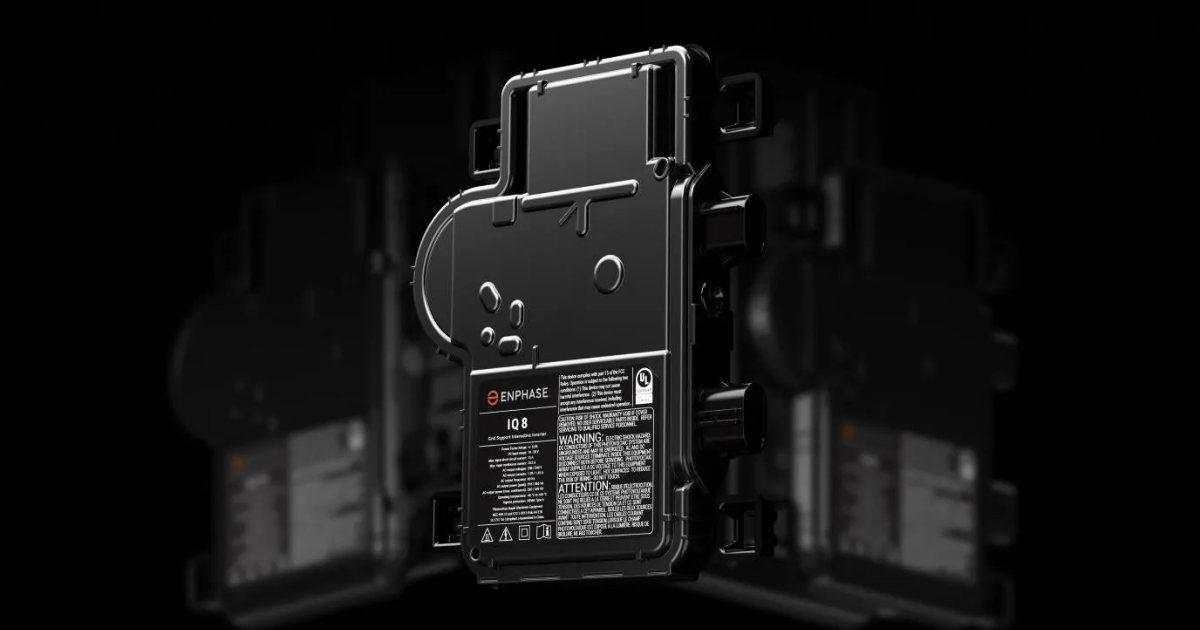
Enphase Energy has announced its IQ8 microinverters should begin shipping in December for customers in North America. Hopefully, shipments to Australia won’t be far behind.
First, a quick summary of what a microinverter is:
In a conventional rooftop solar power system, all the solar panels feed their output to a single solar inverter, which is usually mounted on the wall next to the home’s switchboard/meter box. Known as a “string inverter” and around the size of a briefcase, it converts the DC power from the panels into AC for use in the home and export to the grid.
In a microinverter-based system, a small device around the size of a paperback book is used with each solar panel to perform this function. It’s either installed on the mounting system rail beneath the solar panel, or in the case of “AC solar panels” integrated on the back of the panel at the factory.
You can learn more about the pros and cons of microinverters here.
Enphase IQ8 Microinverter Has 4 Modes
An eagerly anticipated feature of the IQ8 is its “grid-forming” functionality.
With most grid-connected solar power systems, if mains grid electricity supply is cut, the solar inverter will shut down too. This is called “anti-islanding” and helps protect grid hardware and workers attempting to restore power. To have power to your home during a blackout usually requires battery storage (or a generator) – and solar battery systems have varying capabilities in such an event.
This changes with the Enphase IQ8 – it can form a microgrid during a blackout, meaning backup power can be provided to a home from its rooftop solar panels, and without a battery. This mode is called “Sunlight Backup”.
The IQ8 can be configured in 4 different ways:
- “Solar Only” for a standard grid-tied system
- “Sunlight Backup” with no battery
- “Home Essentials Backup” with a small battery
- “Full Energy Independence” with a large battery
I don’t have indicative pricing on the IQ8, but “Sunlight Backup” (and the two battery configurations) also require an Enphase System Controller (Enpower Smart Switch) to island the home during an outage, which is a rather pricey box of tricks. The battery modes will also of course require an Enphase battery system.
The Enphase IQ8 will be available in five flavours: IQ8, IQ8+, IQ8M, IQ8A and IQ8H; which have varying peak output capacities. Enphase says the H can support panels up to 540W.
Unfortunately, the link to the IQ8 datasheet was busted at the time of writing, so I’m not able to provide much more in the way of technical detail at this point in time.
Update 7.45pm: The IQ8 microinverter datasheet (USA – includes the standard, +, M, A and H models) can be downloaded here.
North American pre-orders for the IQ8 family of microinverters began today, with production shipments expected in December for those distributor and installer partner customers. There wasn’t any mention in the announcement of when the IQ8 will be available in Australia.
Also not mentioned by Enphase was status on the IQ8 D, a 640-watt microinverter capable of supporting two panels for small commercial solar installations (but there is a US datasheet for it here).
While microinverter based solar systems still aren’t all that common in Australia, they are in the USA; so there should be plenty of feedback on how the IQ8 stacks up early in the new year to add to that from pilot installations already occurring.
To date, more than 36 million Enphase microinverters have been shipped worldwide.

 RSS - Posts
RSS - Posts



Having recently installed a 12.5kW solar inverter it is frustrating yet again to experience another severe storm grid outage especially as it is beautifully sunny outside. A 3.5kw generator is at least keeping the fridges running this time.
I fully appreciate the need for safety but isn’t it possible to design a system that would support this. Wouldn’t a break before make manual isolator at the main switch board provide for the safety? While new systems might start to incorporate such functionality within the new inverters is there anything happening for potential retro fit devices between an existing inverter and the grid switchboard?
Are there other issues? If there is no grid to connect too are there any ramifications of the power that is not consumed by the house? Though currently the PV side is still adsorbing 12.5kw of solar energy – I guess that just goes to temperature rise in the panels.
Or is this just a mechanical engineer’s fantasy dream?
Hi Wayne, Fully appreciate your “grid-out pain”… The IQ8 is the exact answer to your first problem (Grid-out, sunny day and a need for mains power) IQ8 in “Sunny-backup mode”.
As for retrofitting your existing system (you’ve not said what sort of inverter you have…) Existing Enphase micro-inverters (e.g. S-270, IQ7…) will work quite happily with (say) a Powerwall2, utilising the Tesla “Backup Gateway” as the grid isolation device.
As for the DC power not consumed when the system is powered down/off… the panels convert light (not heat) to electricity… sure the panels heat up but no more than is probably usual.
As an aside, the IQ8 system “throttles” the micros to adjust for load in a backup situation and is also “smart” enough to vary the output AC voltage (within limits of course) to cover for marginal (house) overload during backup mode. Also does “black-start” as required (with or without batteries).
IMHO, the IQ8 system is the best thing to come along since “sliced bread”!
BTW, I am just an enthusiast for Enphase gear. (No sales here!)
(Sydney- NSW Au.)
Any further info on arrival in Oz for the IQ8. Do you expect sunlight BU to be cheaper alternative than a grid with battery system